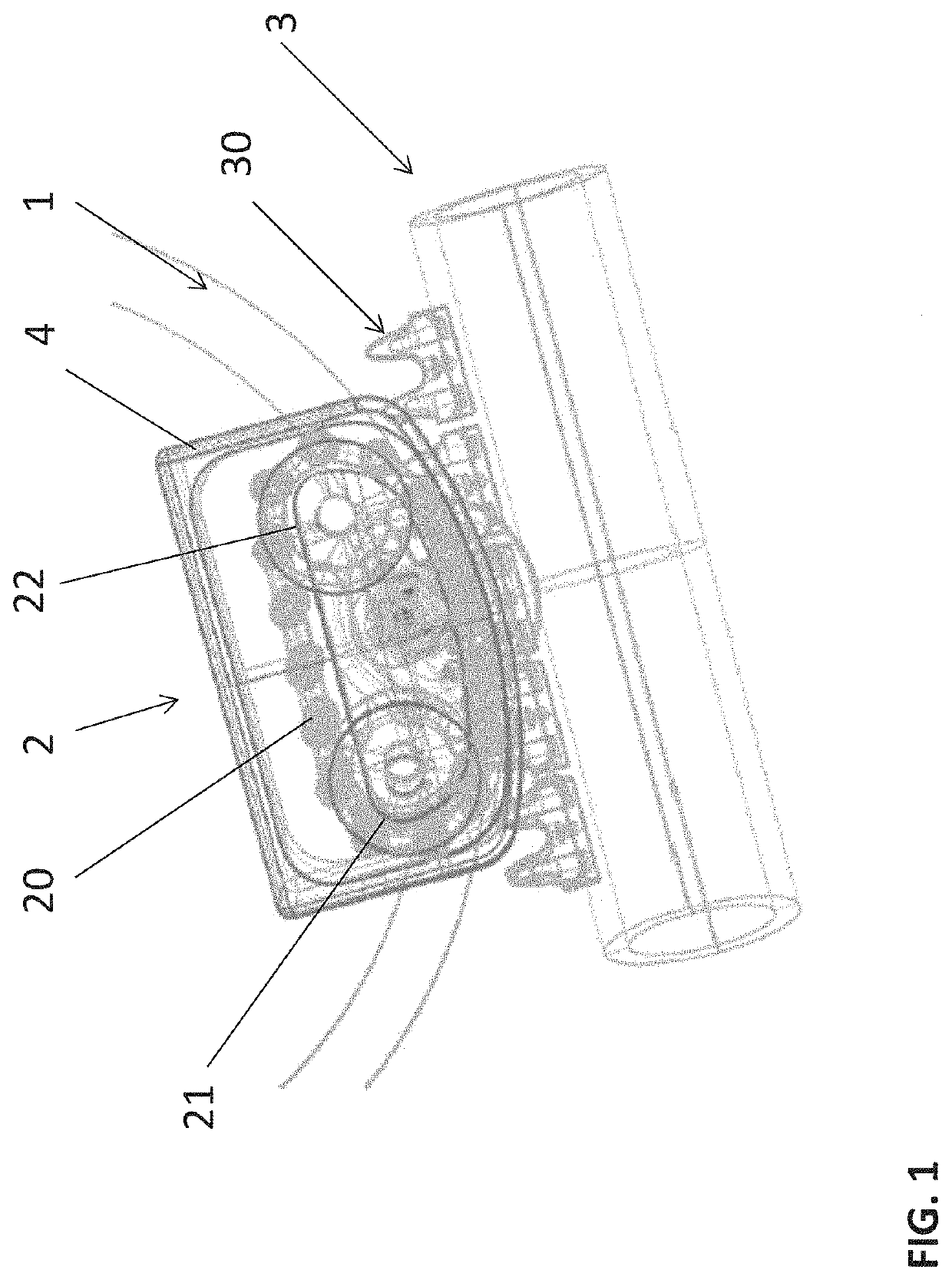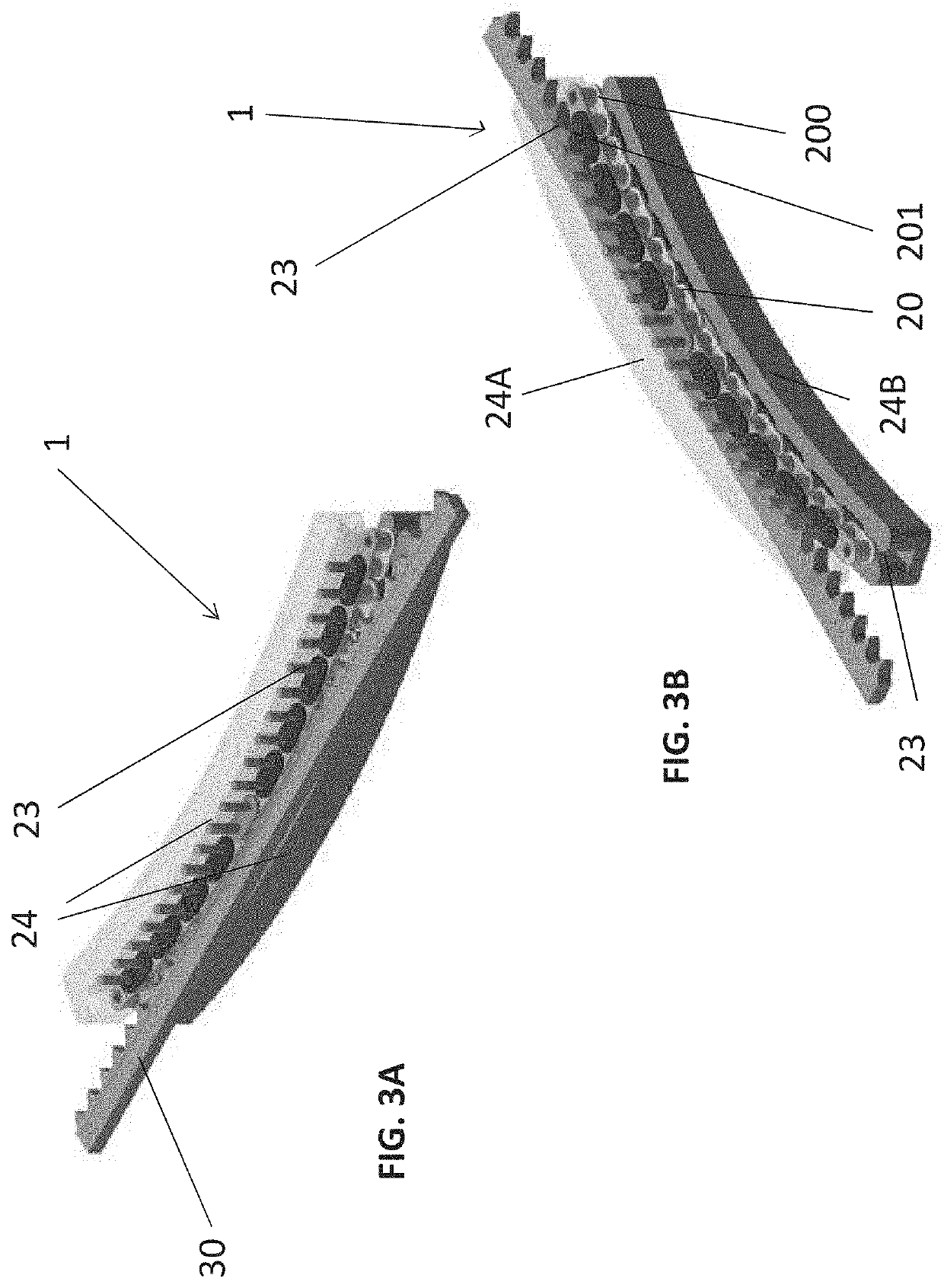Chain drive
a chain drive and drive shaft technology, applied in mechanical equipment, transportation and packaging, gearing, etc., can solve the problems of increasing the required installation space, limiting power transmission, and inability to facilitate the transmission of the motor to the counter-toothing
- Summary
- Abstract
- Description
- Claims
- Application Information
AI Technical Summary
Benefits of technology
Problems solved by technology
Method used
Image
Examples
first embodiment
[0053]FIGS. 3A and 3B show drive system 2, from two different perspectives. In this example, each chain link has guide components 23 in the form of guide pins extending on both sides from the pins of the drive chain. The guide pins can be extensions / extended components of the pins of the drive chain 20 which protrude laterally (i.e., vertically in FIGS. 3A and 3B) from the drive chain 20.
[0054]The guide components 23 are guided by a guide element 24 (here comprising an upper guide element 24A and a lower guide element 24B) which has at least one groove in which the guide pins engage. The guide element 24 is arranged in an area of the drive element 2 in which the drive chain 20 is intended to engage in / mesh with the counter-toothing 30, as shown in FIGS. 3A, 3B.
second embodiment
[0055]FIGS. 4A and 4B show drive system 2, from two different perspectives. In this example, each chain link has guide components 23 in the form of sliding bushes or rollers extending on both sides from the links of the drive chain 20. The sliding bushings can roll independently of the drive chain 20 on a guide element 24 (here comprising an upper guide element 24A and a lower guide element 24B). The guide element 24 may have a curved guide surface with a large radius, for example, with which the rollers of the drive element 2 are in contact in the engagement section of the drive element 2 and along which they roll in order to guide the drive chain 20 in this section. This reduces the friction generated by the guide (as rolling friction instead of sliding friction). This variant comprises a rolling bearing. The guide element 24 is arranged in at least one area of the drive element 2 in which the drive chain 20 is intended to engage in / mesh with the counter-toothing 30, as shown in F...
third embodiment
[0056]FIGS. 5A and 5B show drive system 2, from two different perspectives. In this example, the guide components 23 for the drive chain 30 are designed in the form of a guide chain (or its components) which is arranged laterally on the drive chain 30 and connected to it. In this case, two guide chains 23A and 23B are provided, one of which is attached to each side of the drive chain 30. The drive chain 20 and the guide chains 23 are connected to each other so that the guide chains 23 guide the drive chain 20.
[0057]The guide chains 23A and 23B interact with the guide element 24 to guide the drive chain 23. The guide element 24 may comprise a guide surface or a groove on / in which the guide chain slides. Preferably, however, the guide element 24 has a structure along which the rollers of the guide chain 23 can roll or unroll. For example, a profile can be provided on the guide element 24 on which the rollers of the guide chain(s) roll along, e.g., a burr arranged between the chain lin...
PUM
 Login to View More
Login to View More Abstract
Description
Claims
Application Information
 Login to View More
Login to View More - R&D
- Intellectual Property
- Life Sciences
- Materials
- Tech Scout
- Unparalleled Data Quality
- Higher Quality Content
- 60% Fewer Hallucinations
Browse by: Latest US Patents, China's latest patents, Technical Efficacy Thesaurus, Application Domain, Technology Topic, Popular Technical Reports.
© 2025 PatSnap. All rights reserved.Legal|Privacy policy|Modern Slavery Act Transparency Statement|Sitemap|About US| Contact US: help@patsnap.com



